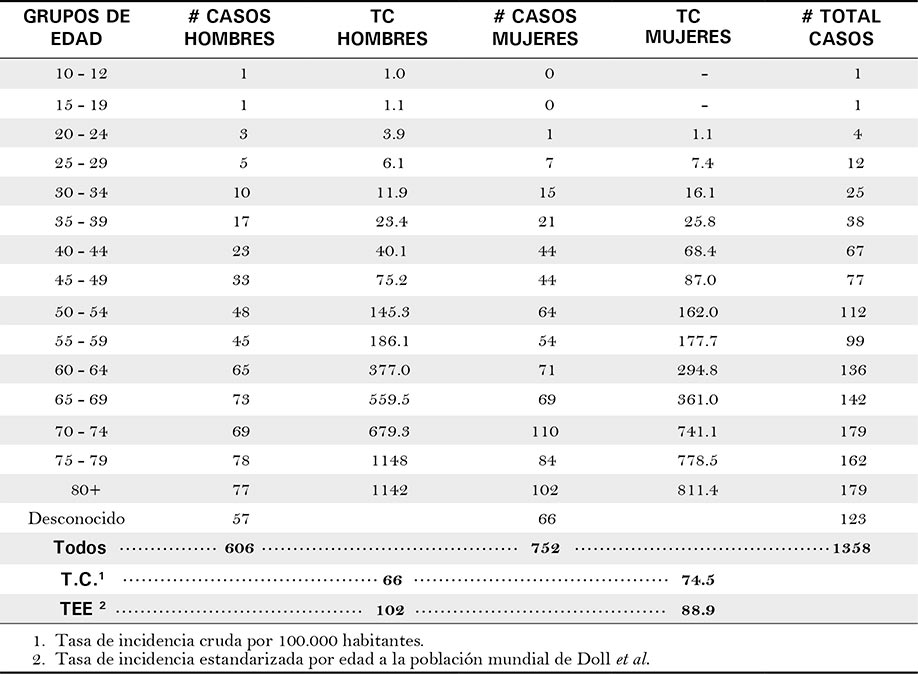Epidemiology of basal cell carcinoma. 1423 cases reported on population based cancer registry.
Keywords:
Basal cell carcinoma (BCC), epidemiology, skin neoplasmAbstract
Background: Basal cell carcinoma (BCC) is the most common type of skin cancer and represents 81.55% of malignant epithelial tumors. It usually occurs on the face in individuals aged over 40 years, and it is related with repetitive exposure to sunlight.
Objective: To describe the epidemiological data, and histopathology findings of 1423 patients with BCC.
Design: Descriptive analysis of incidence rates for BCC from 2000 and 2001, in relation to sex, age, anatomical distribution, and histopathology type.
Setting: Data were obtained from the Bucaramanga Metropolitan Area Population based Cancer Registry, to which registering the data of skin cancer was compulsory in 2000 and 2001.
Patients: Inhabitants of Bucaramanga Metropolitan Area (961,759 in 2000).
Main outcome measures: Age-and sex-specific incidence rates and overall rates adjusted for age to the world standard population.
Methods: Data from 2000 to 2001 was obtained from the Bucaramanga Metropolitan Area population-based Cancer Registry. Age-standardized incidence rates (ASRs) and percentage of frequency, were calculated. The Bucaramanga Metropolitan Area population-based Cancer Registry with more than 100 registering information sources investigates all incident cancer cases according to international standards. From the recorded data all BCC cases were identified and evaluated.
Results: A total of 1423 BCCs were registered. During the study period, the age-standardized incidence of BCC was high for males and females, reaching 112.7 and 94.3 per 100,000 per year, respectively. Most patients were female (55%) and involving predominantly the face (87.6%) of the lesions). The most frequent pathological type was solid variant (72.8% of the lesions).
Conclusions: The first population-based data from Bucaramanga Metropolitan Area on the characteristics (age, sex, histological subtypes, and localization) of BCC agree well with the existing literature and may thus be regarded as representative.
Author Biographies
Claudia Uribe
Patóloga, Dermatopatóloga. Directora Registro de Cáncer del área metropolitana de Bucaramanga. Profesora asociada de la facultad de medicina de la Universidad Autónoma de Bucaramanga.
Erika Meza
Enfermera. Coordinadora del Registro de Cáncer del área metropolitana de Bucaramanga. Facultad de medicina de la Universidad Autónoma de Bucaramanga.
Mabel Ávila
Dermatóloga, Dermatopatóloga. Centro Dermatológico área metropolitana de Bucaramanga.
References
2. Naldi L, Dilandro A, DAvanzo B, Parazzini F. Host-related and environmental risk factors for cutaneous basal cell carcinoma: Evidence from an Italian case-control study. J Am Acad Dermatol. 2000;42: 446-52.
3. Carucci JA, Leffell DJ. Basal cell carcinoma. In: Freedberg IM, Eisen AZ, Wolff K, Austen KF, Goldsmith LA, Katz SI, editors. Fitzpatricks dermatology in general medicine. USA: McGraw-Hill; 2003. p.747-54.
4. Green A, Battistutta D, Hart V, Leslie D, Weedon D, Nambour Study Group. Skin cancer in a subtropical Australian population: incidence and lack of association with occupation. Am J Epidemiol. 1996;144:1034-40.
5. Demers AA, Nugent Z, Mihalcioiu C, Wiseman MC, Kliewer EV. Trends of nonmelanoma skin cancer from 1960 through 2000 in a Canadian population. J Am Acad Dermatol. 2005;53:320-8.
6. Bandeira AM, Bandeira V, Silva JF, Mazza E. Carcinoma basocelular: estudo clínico e anatomopatológico de 704 tumores. An Bras Dermatol. 2003;78:23-34.
7. Bastiaens MT, Hoefnagel JJ, Bruijn JA, Westendorp RGJ, Bavinck VNB, Bavinck JNB. Differences in age, site distribution, and sex between nodular and superficial basal cell carcinomas indicate different types of tumors. J Invest Dermatol. 1998;110:880-4.
8. Katz MH. Nonmelanoma skin cancer. Maryl Med J. 1997;46:238-42.
9. Corona R. Epidemiology of nonmelanoma skin cancer: review. Ann Ist Super Sanità. 1996;32:37-42.
10. Bale AE, Yu K. The Hedgehog pathway and basal cell carcinomas. Hum Mol Genet. 2001;10:757-62.
11. Franceschi S, Levi F, Randimbison L, La Vecchia C. Site distribution of different types of skin cancer: new aetiological clues. Int J Cancer. 1996;67:24-8.
12. Mantese AO, Berbert CV, Gomides DA, Rocha A. Basal cell Carcinoma - Analysis of 300 cases observed in Uberlândia - MG, Brazil. An. Bras. Dermatol. 2006 ; 81: 136-42.
13. Maia M, Proença NG, Moraes JC. Risk factors for basal cell carcinoma: a case-control study. Rev Saude Publica. 1995; 29:27-37.
14. Betti R, Inselvini E, Carducci M, Crosti C. Age and site prevalence of histologic subtypes of basal cell carcinomas. Int J Dermatol. 1995; 34:174-6.
15. Benjamin L, Nancy S, Ronald H. Basal Cell Carcinoma in Children: Report of 3 Cases. Arch Dermatol. 2000; 136: 370 - 2.
16. McKie RM. Epidermal skin tumors. In: Champion RH, Burton JL, Burns DA, Breathnach SM, editors. Rook/Wilkinson/Ebling: textbook of dermatology. London: Blackwell Science;2004. p.1651-93.
17. Minelli L. Estudo estatístico do carcinoma basocelular em Londrina, Paraná, Brasil. An Bras Dermatol. 1987; 62:321-5.
18. Dahl E, Aberg M, Rausing A, Rausing EL. Basal cell carcinoma. Cancer. 1992; 70:104-8.
19. Holme AS, Malinovszky K, Roberts DL. Changing trends in non-melanoma skin cancer in South Wales, 1988-98. Br J Dermatol. 2000;143:1224-9.
20. Kopke LFF, Schmidt SM. Carcinoma basocelular. An Bras Dermatol. 2002; 77:249-82.
21. Katalinic A, Kunze U, Schafer T. Epidemiology of cutaneous melanoma and non-melanoma skin cancer in SchleswigHolstein, Germany: incidence, clinical subtypes, tumour stages and localization (epidemiology of skin cancer). Br J Dermatol. 2003;149:1200-6.
22. Rojas RF, Díaz LA. Características clínicas de los pacientes con carcinoma basocelular: Una serie de 305 casos en Bucaramanga. MEDUNAB 2002; 5:69-74.
23. Green A, Battistutta D. Incidence and determinants of skin cancer in a high-risk Australian population. Int J Cancer. 1990; 46:356-61.
How to Cite
Downloads

Downloads
Published
How to Cite
Issue
Section
| Article metrics | |
|---|---|
| Abstract views | |
| Galley vies | |
| PDF Views | |
| HTML views | |
| Other views | |






